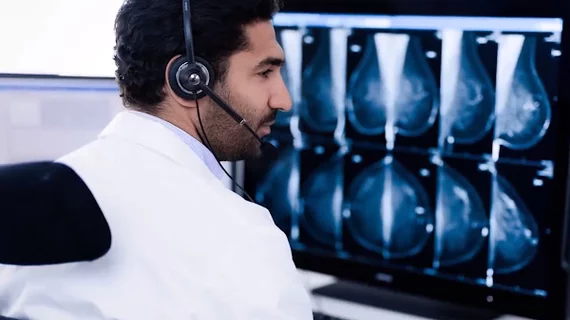Benefits of DBT vary 'substantially' depending on the individual radiologist
A number of radiologists have screening mammography recall rates above the recommended threshold. Although digital breast tomosynthesis has generally brought those figures down, new research suggests this may depend more on the individual radiologist rather than the modality itself.
A multi-institutional team of experts analyzed millions of breast cancer screening exams (DBT and mammography) interpreted by nearly 200 radiologists for their study, published March 30 in JAMA Network Open. They found that while DBT produced lower recall rates and improved cancer detection overall, there was “wide variability” among individual imaging physicians.
Most of the DBT-focused radiologists (76%) had unadjusted recall rates within the ACR-recommended threshold of 12%. Those who performed these digital exams, more often than not, were also less likely to have exams recalled for reevaluation, reported Brian L. Sprague, PhD, with the University of Vermont’s Department of Surgery in Burlington, and colleagues.
“Our results demonstrate a clinically important downward shift in the distribution of radiologist recall rates with DBT screening among a large, geographically diverse sample of U.S. radiologists,” the authors added. And given these findings, “radiology practices should audit radiologist DBT screening performance and consider additional DBT training for radiologists whose performance does not improve as expected,” they added later.
For their study, the researchers set out to test recall and cancer detection rates before and after radiologists began performing DBT exams. They grabbed data from the Breast Cancer Surveillance Consortium, which includes more than 100 facilities and upwards of 2 million images.
After radiologists began using DBT, the mammography recall rate fell to 8.8%, down from 10% prior to introducing the modality. And a larger proportion of individuals fell within the ACR-mandated recall rate threshold of 12% after implementing DBT (76% compared to 66%).
Additionally, after adjusting for multiple variables and trends, DBT exams yielded even lower recall rates (15%) compared to digital mammography.
Despite these gains, Sprague and colleagues keyed in on the wide variety of rate improvement between radiologists. Exactly half of all imaging experts had no change in their recall rate after performing DBT, while 14% did show improvement.
“The observed variability indicates that decreased recall on DBT is not universal,” the authors added. They found no pattern between radiologist specialty, fellowship training, or practice characteristics, but did determine that those who performed DBT more than 50% of the time were more likely to reduce their rate of recall.
More research will be required to pin down individual factors for these findings, the team wrote, but lawmakers and patients should both be aware that the overarching trend does not necessarily apply to everyone.
“Policy makers and women should be informed that most women undergoing DBT examinations will experience a reduced recall rate and elevated cancer detection rate, although these benefits will vary substantially depending on the individual radiologist interpreting the examination,” the team concluded.

